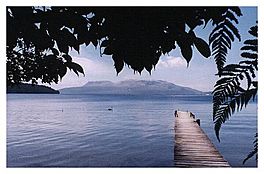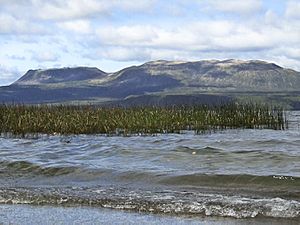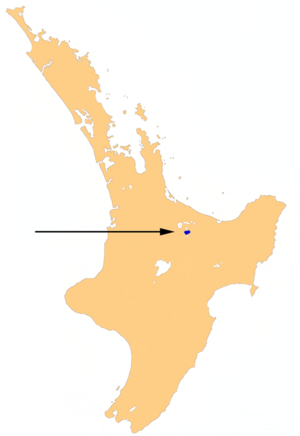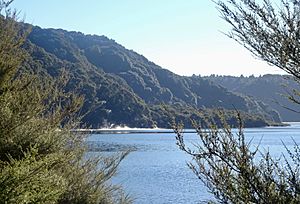Lake Tarawera facts for kids
Quick facts for kids Lake Tarawera |
|
|---|---|
 |
|
| Location | Rotorua Lakes, Bay of Plenty Region, North Island |
| Coordinates | 38°12′S 176°27′E / 38.200°S 176.450°E |
| Basin countries | New Zealand |
| Max. length | 11.4 km (7.1 mi) |
| Max. width | 9.0 km (5.6 mi) |
| Surface area | 41.0 km2 (15.8 sq mi) |
| Average depth | 57.0 m (187.0 ft) |
| Max. depth | 87.5 m (287 ft) |
| Surface elevation | 298 m (978 ft) |
Lake Tarawera is a large lake in the North Island of New Zealand. It is the biggest of several lakes around the volcano Mount Tarawera. The lake sits inside a huge volcanic crater called the Okataina caldera.
You can find Lake Tarawera about 18 kilometres (11 mi) east of Rotorua. It lies beneath the tall peaks of the Tarawera mountains. The lake covers an area of about 39 square kilometres (15 sq mi).
Contents
Lake Tarawera: A Volcanic Lake

Lake Tarawera was greatly changed by the huge eruption of Mount Tarawera. This happened on June 10, 1886. The eruption blocked the lake's exit, causing the water level to rise for 20 years.
The eruption was very powerful. It sadly killed over 150 people. It also buried the Māori village of Te Wairoa. This village was located on the southwest shore of the lake.
The Lost Terraces
The famous Pink and White Terraces were thought to be destroyed by the 1886 eruption. These terraces were beautiful natural formations. They were made of minerals from hot springs.
In 2011, a team exploring the lake floor found something exciting. They discovered what looked like parts of the Pink Terraces. The lowest sections were found about 60 metres (200 ft) deep. Later that year, parts of the White Terraces were also reportedly found. This discovery happened around the 125th anniversary of the eruption. Scientists thought that other parts of the terraces might be buried under mud.
However, newer studies suggest that the original spots of the Pink and White Terraces might actually be on land. They might not be under the lake after all.
What's in a Name?
The name "Tarawera" means "Burnt Spear" in the Māori language. This name comes from a story about a hunter. He left his bird spears in a hut. When he came back the next season, both the spears and the hut had completely burned down.
Water Sources and Activities
Most of the water in Lake Tarawera comes from water flowing through volcanic rocks and ash. Only about 42% of its water comes from streams.
The lake is a home for eels and rainbow trout. In the summer, many people visit the lake. It is popular for fishing and water sports like boating. It's also a great place for camping.
Hot Water Beaches
Lake Tarawera has several "hot water beaches." These are places where warm water from underground heats the sand. You can dig a hole and create your own hot pool!
The main hot water spots are in the southern part of the lake. These include Wairua Stream, Hot Water Beach, and Te Puha. The water temperature in these areas can range from 37 °C (99 °F) to 90 °C (194 °F). There is also a smaller hot area at Humphrey's Bay.
Lake Outflow
The water from Lake Tarawera flows out from its northeast end. This water forms the Tarawera River. The river then flows northeast until it reaches the Bay of Plenty.




